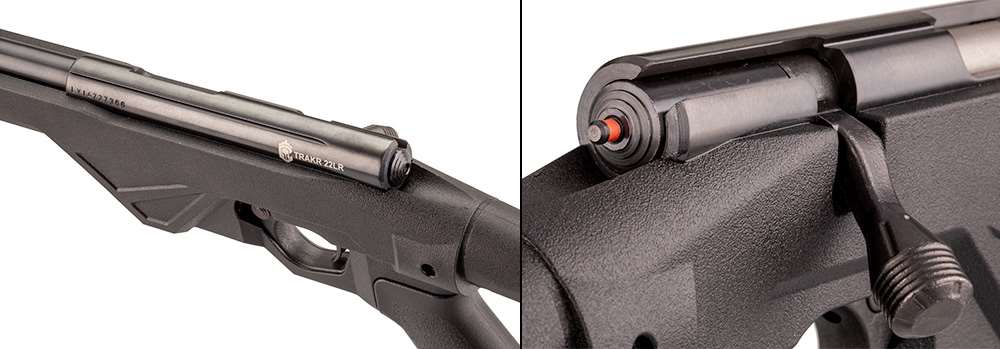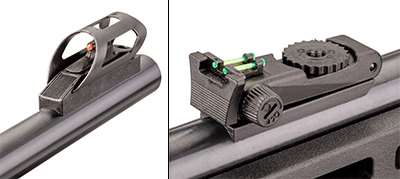Where recoil mitigation is concerned, few solutions trump a healthy serving of additional mass. However, if the cartridge in question doesn’t produce a whole lot of kick, keeping the firearm trim probably makes more sense. Case in point, Citadel’s Trakr bolt-action rimfire is missing more than just a few letters—at less than 4 lbs., this repeating rifle is easy on the back while also being extraordinarily easy on the budget. Chambered in .22 Long Rifle, .22 WMR or .17 HMR, we reached out to Legacy Sports Intl. to procure a sample chambered in the former to see how it fared during formal testing.
The heart of this Trakr is a slimline bolt-action mechanism with an extractor on the right and an opposed guide that securely handles cartridges and spent cases as they are run to and from the chamber. Ammunition is drawn from a 10-round detachable box magazine. Pressed and pinned to the receiver is an 18″ carbon-steel barrel that is finished with a conventional bluing process and topped with a set of fiber-optic sights; it is of a thin contour and, in its .22 LR rendition, is not threaded at the muzzle. The rear sight is fully adjustable, and a 3/8″ dovetail is cut into the receiver for easy scope mounting. There are only two controls on the Trakr: the magazine release and the safety. Pressing forward on a recessed lever directly behind the magazine well allows the box magazine to be removed from the rifle. The safety is of the crossbolt variety and is located just in front of the trigger.

While it comes with irons, those who would prefer to mount an optic atop the bolt-action Citadel Trakr will find a 3/8″ dovetail (l.) for this purpose. A cocking indicator at the back of the bolt (r.) provides visual confirmation that the rifle is ready to fire.
While the Trakr’s receiver is quite similar to that of other inexpensive rimfire bolt guns on the market, such as the Mossberg 802 Plinkster and the Rossi RB 22, its stock is radically different. Comprised entirely of polymer, it floats the barrel along its entirety and skips the additional weight of aluminum bedding. A move that might cost it a bit of accuracy, this simpler approach helps keep both the weight and the price point down. Superb ergonomics are achieved through AR-style furniture.

The rifle’s sights consist of three fiber-optic pipes; the front post is fixed, but the rear is adjustable for both windage and elevation.
The rifle’s buttstock may appear to be adjustable at first glance, but it is a continuous piece of molded polymer that provides a fixed 13 5⁄8″ length of pull. Citadel calls the fore-end “vented,” which apparently means it features M-Lok slots on both sides and its bottom. For our testing, we outfitted the Trakr with a Magpul MOE Bipod and a Tract 22 Fire 4-12X 40 mm scope. To accomplish this without resorting to extra-high scope rings, we removed the rear sight by unscrewing the adjustment wheel and backing out the two mounting screws.
With our rifle now ready for the range, it was time to select test ammunition. Considering the rifle’s economical $179 MSRP, we opted to use affordable loads in our testing. We chose CCI’s new segmented Mini-Mags, Remington’s lighter 22 Vipers and Aguila’s relatively hard-hitting Interceptors.

Pressing forward on a recessed lever directly behind the magazine well (r., arrow) allows the box magazine to be removed. The extractor acts in conjunction with an opposed guide (l.) to control cases to and from the chamber.
We began testing from a bench, with the rifle supported both fore and aft. Each shooter remarked on the trigger being of higher quality than initially expected; measuring just north of 5 lbs., it was fairly light for a low-dollar rifle, and we did not expect it to break as cleanly as it did. Accuracy was not exceptional, but our test rifle did seem to have a preference for the 36-grain Viper load, which we then used to engage targets during a woods walk to simulate field use. But before stepping away from the bench, we removed the scope, re-installed and re-zeroed the rear sight to get a feel for the rifle in the condition it would arrive at a dealer.
The woods walk consisted of a total of 10 Caldwell AR-500 steel targets that ranged from 23 to 125 yards. Each tester was to walk the course and engage each with no more than three rounds, using only what was available from Mother Nature for support. Shooters were challenged to fire offhand, sitting and kneeling, as well as while maneuvering around boulders and through a bevy of vegetation. All enjoyed the weight-saving measures taken by Citadel, as we found the rifle extremely easy to carry and fire offhand.

We concluded the day by tallying hits, with each tester scoring better than 85 percent. This is a tough feat on this course, as it is designed to induce uncomfortable shooting. Overall, Citadel’s affordable rimfire provided trouble-free operation, simple execution and features that might seem to be outside of its price range. This firearm can fill many roles, including as a trainer for new shooters or as a small-game hunting tool. Given how gentle it is on the pocketbook, it’s also a great firearm to purchase as you figure out where the shooting sports will take you.

Read the full article here

